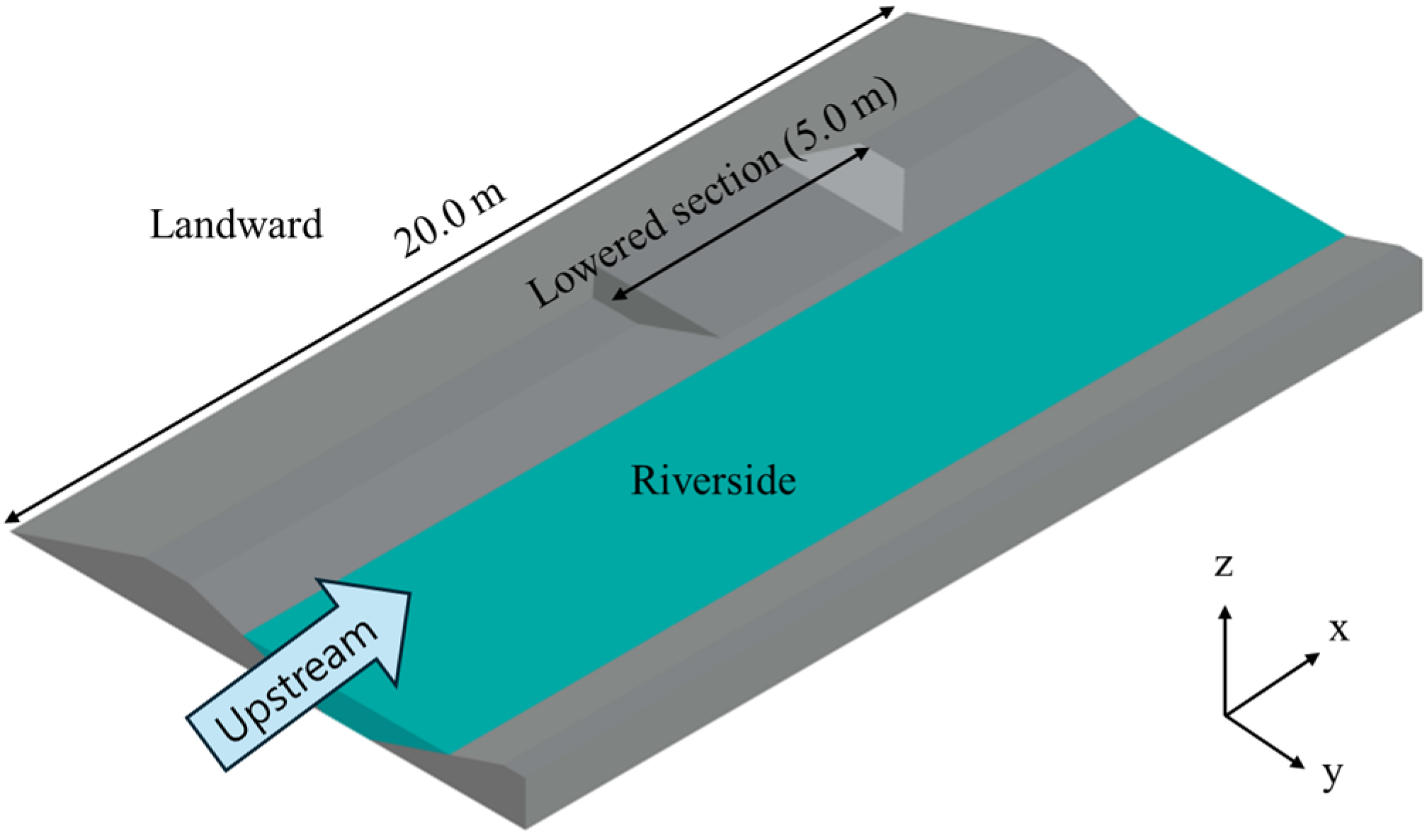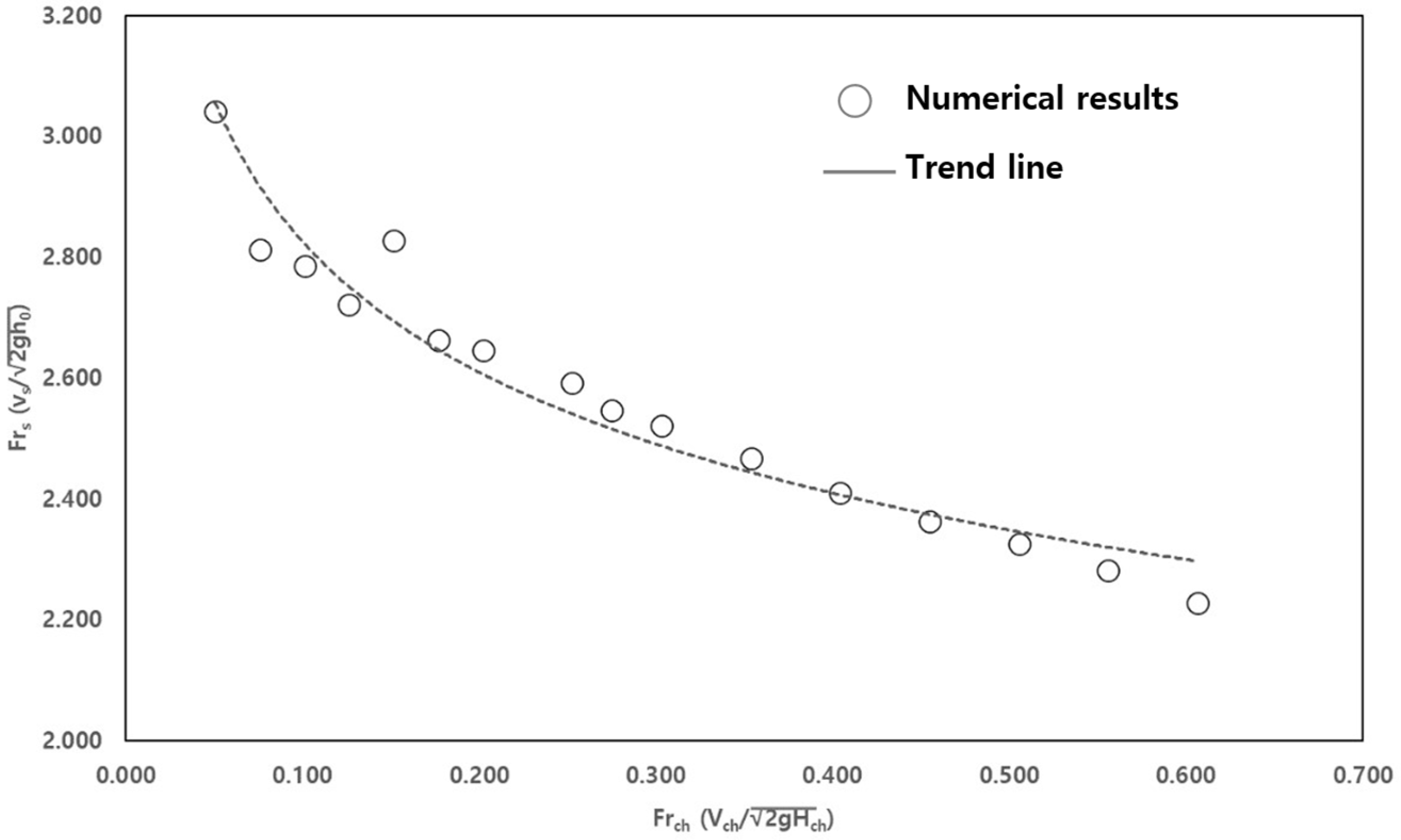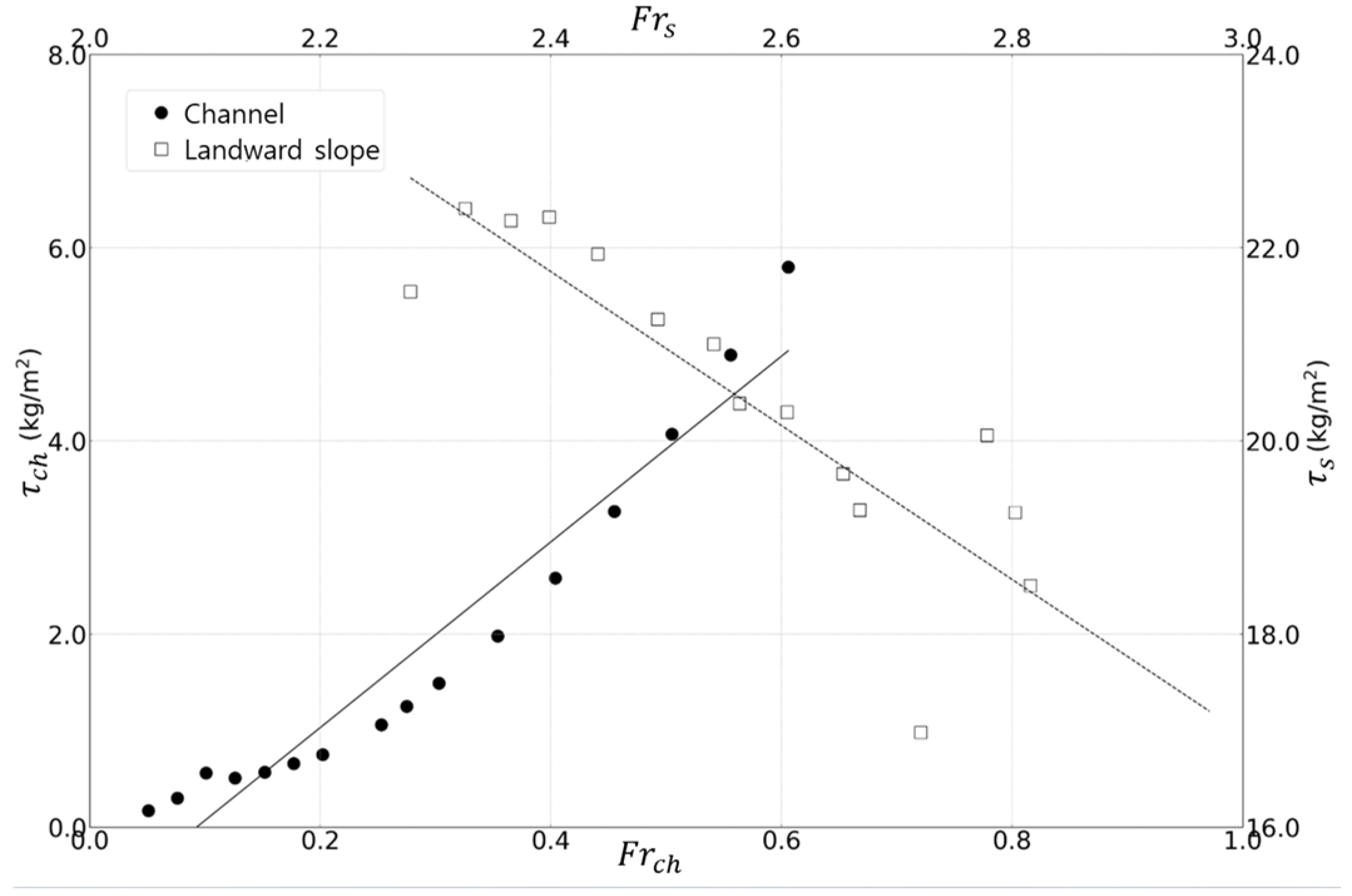1. Introduction
In recent years, the frequency of localized torrential rainfall and extreme precipitation events has been increasing due to the impacts of climate change. Consequently, the probability of rising flood levels in rivers and the overtopping of levees is also increasing. River levees, which are predominantly constructed using earthen materials, are particularly vulnerable to structural instability when subjected to the hydraulic loads induced during flood events. Studies from flood-prone regions in Europe, North America, and Asia have consistently reported overtopping and erosion as the leading causes of levee failures, typically accounting for over 70–80% of total failure cases [
1].
Overtopping occurs when the flood discharge exceeds the conveyance capacity of the river channel, or when debris or sediment reduces that capacity. Erosion, on the other hand, typically takes place in steep or highly curved river sections, where excessive flow velocities and tractive forces scour the levee slopes and/or toe regions [
2]. Additionally, the investigation of 230 levee overtopping cases across the United States from 1948 to 2019 reported that approximately 65% of the incidents resulted in levee failure [
3]. These results indicate a high likelihood of structural failure following overtopping. However, most studies have focused on channel flow or overall failure mechanisms, and quantitative analyses of flow characteristics on the landward slope of levees remain relatively limited. Since slope velocity can induce localized scour and structural damage on the surface of the landward slope of levees, understanding it is another key factor in ensuring levee stability.
To address these challenges, extensive research has been conducted to investigate levee overtopping mechanisms and develop mitigation strategies. Various reinforcement techniques, including riprap, geotextiles, concrete blocks, soil improvement, sheet piles, and geogrid systems, have been applied to enhance erosion resistance and stability. However, most studies have focused on experimental validations, with limited quantitative analyses of flow behavior during overtopping. While early studies relied primarily on hydraulic experiments, recent research has increasingly shifted toward numerical modeling capable of addressing complex conditions.
Wu [
4] proposed a simplified physically based model to simulate earthen embankment breaching caused by overtopping and piping. Han and Choi [
5] proposed an empirical formula for estimating segmental tractive forces based on slope gradients for levee slopes composed of cohesive soils and analyzed the allowable tractive force under varying revetment materials and vegetation densities using hydraulic model tests. Kim et al. [
6] conducted a study comparing the scour resistance of native soil and soil-improvement materials to ensure the hydraulic stability of riverbanks and proposed optimal mixing ratios and material properties suitable for revetment reinforcement. Go et al. [
7] validated the effectiveness of levee reinforcement methods through large-scale overtopping collapse experiments using full-scale levee models and quantitatively evaluated slope erosion rates using image-based analysis techniques. Lee et al. [
8] analyzed the collapse delay effects of reinforcement layouts on slope through laboratory experiments aimed at preventing levee failure under extreme rainfall conditions. They found that the collapse time increased with the installation of reinforcements, with variations depending on the configuration of the reinforcements. Hughes and Nadal [
9] experimentally analyzed flow characteristics on the crest and landward slope of levees under combined conditions of wave overtopping and storm surge and proposed empirical formulas for estimating overtopping discharge and channel velocity. Feliciano Cestero et al. [
10] examined the influence of variations in particle size distribution and soil cohesion on levee failure behavior during overtopping through laboratory experiments. They quantitatively assessed the correlation between failure width, location, and geotechnical properties. Islam [
11] conducted experimental studies on the effects of bed material composition and relative bed elevation on levee breach behavior, revealing that elevated bed levels significantly accelerate both horizontal and vertical failure processes of the levee.
Cho [
12] performed probabilistic numerical simulations coupled with infiltration analysis to examine slope failure induced by rainfall infiltration, and proposed rainfall thresholds for failure prediction through Monte Carlo-based slope stability assessments. Kim et al. [
13] carried out three-dimensional numerical analyses of infiltration and slope stability in levees, identifying vulnerable sections by comparing various cross-sectional profiles and analyzing discrepancies among different modeling approaches. Sharp and McAnally [
14] employed numerical simulations to calculate flow velocity, water depth, and shear stress under overtopping conditions, and analyzed the distribution of shear stress in relation to changes in water level and surface roughness, thereby suggesting design thresholds applicable for levee protection. Hu et al. [
15] proposed a new slope failure parameter that incorporates sediment transport and flow conditions to simulate overtopping-induced levee collapse. Xiao et al. [
16] applied a numerical model to investigate wave overtopping of a levee during Hurricane Katrina. Li et al. [
17] conducted a numerical study on combined wave overtopping and storm surge overflow for HPTRM-strengthened levees. Their approach, applied to a numerical model, demonstrated improved accuracy in predicting breach geometry and outflow discharge compared to previous models. Previous studies on levee overtopping have primarily focused on the mechanisms of levee failure, estimation of overtopping discharge, and analysis of scour initiation conditions. Although some research has qualitatively analyzed overtopping behavior using dimensionless parameters such as the Froude number, there has been limited effort to quantitatively predict the velocity distribution along the landward slope based on the relationship between upstream inflow discharge and the resulting flow regime.
Table 1 provides a summary of previous studies on levee overtopping and reinforcement strategies.
Accordingly, this study aims to predict the landward slope flow velocity based on key hydraulic parameters, including Froude numbers, levee height, and overtopping flow depth, using numerical simulations. Through this approach, this study seeks to identify the correlation between channel flow conditions and landward slope flow behavior. Furthermore, by non-dimensionalizing the flow characteristics, this study derives generalized variables applicable to various levee scales and flood scenarios, which are expected to be widely applicable in levee design, planning for levee reinforcement, and levee maintenance.
4. Results and Discussion
4.1. Levee Overtopping Flow
In this study, overtopping was intentionally induced at a designated settlement zone located at the center of the left-bank levee. This zone featured a locally reduced crest elevation to concentrate overtopping flow, representing a location that is particularly susceptible to early-stage overtopping during actual flood events. The flow acceleration near the levee crest was captured through three-dimensional simulation using FLOW-3D. Accordingly, overtopping depth and slope flow velocity were evaluated at this designated section for all simulation cases. To assess the hydraulic response of the landward slope under overtopping conditions, the landward slope velocity (LSV) is defined as the maximum velocity occurring near the toe of the landward slope. In addition, the overtopping depth and velocity values presented in this study were extracted as their respective maximum values. The overtopping depth was generally measured at the levee crest, while the velocity was measured near the toe of the slope, where the flow, after developing along the slope, reached its maximum speed.
As shown in
Figure 4, overtopping depth was measured at the levee crest within the settlement zone. At the same time, the slope velocity was evaluated at a specified location on the landward slope surface.
Simulation results indicated that the maximum overtopping depth in the settlement area ranged from 0.107 m to 0.254 m, while the maximum slope velocity varied from 3.170 m/s to 3.586 m/s. In general, the critical velocity for initiating erosion on a levee slope depends on various factors, including the levee material, slope gradient, and surface conditions. According to previous studies [
6], the critical velocity for unprotected earthen levees is approximately 1.3 m/s, while even with basic reinforcement methods such as vegetative mats, the threshold typically remains near 3.0 m/s.
Based on this, the maximum slope velocities derived from the simulations suggest a potential for erosion and slope failure if such flow conditions persist for a sufficient duration. Furthermore, as presented in
Table 6, both overtopping depth and slope velocity showed an overall increasing trend with higher inflow discharge. Notably, at higher discharge levels, the overtopping flow exhibited a pronounced tendency to shift downstream in the channel, rather than flowing solely perpendicular to the levee crest. This indicates that the overtopping flow possesses a multidirectional nature, combining both transverse and longitudinal flow components. Analysis of the velocity distribution revealed that the maximum velocity primarily occurred near the toe of the slope. As the inflow discharge increased, flow velocities rose across the entire slope, with a noticeable bias in the flow direction, suggesting a non-uniform and concentrated hydraulic pattern under high-flow conditions. Supercritical flows were observed on the landward slope of the levee, indicating shallow, high-velocity conditions that can cause significant shear stress. Such hydraulic behavior increases the likelihood of erosion, particularly near the toe of the slope, and highlights the need for reinforced protective measures in that region.
4.2. Slope Velocity Variation
The velocity and overtopping depth results presented in the previous section were derived based on a specific levee geometry and inflow discharge configuration. As such, direct comparisons across different river or levee scales may be limited. To develop a more generalized understanding applicable under various conditions, this study employed a non-dimensional analysis to compare the flow characteristics between the main channel and the landward slope of the levee. The Froude number, a dimensionless quantity representing the ratio of inertial forces to gravitational forces in fluid dynamics, serves as a critical indicator for evaluating the dynamic behavior of flow, especially in distinguishing between subcritical and supercritical conditions. To characterize the hydraulic behavior of the river, the Froude number in the main channel was calculated using representative values of flow depth and velocity. Similarly, the Froude number along the landward slope was derived using the overtopping depth and slope velocity. These two Froude numbers are defined as shown in Equations (7) and (8).
where
is the Froude number in the channel,
is the Froude number on the landward slope,
is the mean velocity in the channel,
is the mean velocity on the landward slope,
is the flow depth in the channel,
is the flow depth on the landward slope, and
is the gravitational acceleration.
Analysis of the simulation results revealed that as the Froude number in the main channel increased, the Froude number on the landward slope exhibited a decreasing trend. This inverse relationship indicates that, for a given levee height, increases in overtopping depth result in a relatively moderate increase in slope velocity. In other words, the rate of increase in slope velocity diminishes with deeper overtopping flow. This trend provides a basis for developing a dimensionless relationship by which slope flow velocity can be estimated using overtopping depth alone. Such a formulation would allow for simplified prediction of slope flow behavior under various river conditions, without requiring detailed hydraulic modeling. The relationship between the two Froude numbers is illustrated in
Figure 5, with a clear correlation between the Froude number in the main channel and the Froude number on the landward slope. Through regression analysis, an empirical relationship was derived, as expressed in Equation (9).
This equation enables a dimensionless prediction of velocity on landward slopes of levee during overtopping by using the Froude number as a key indicator. With a coefficient of determination of approximately 0.94, the regression shows a strong correlation, validating its reliability across various flow rates. From an engineering application perspective, this relationship provides a practical tool for estimating LSV without requiring detailed geometric modeling. It facilitates rapid assessments in preliminary design stages, supports safety evaluations of existing levees, and helps determine the need for slope protection measures such as revetments or geotextile layers. Moreover, the use of non-dimensional parameters enhances scalability and transferability across different river sizes, allowing engineers to apply it in both small-scale channels and large river systems with confidence.
4.3. Shear Stress Response of the Landward Slope
The landward slope of levees is significantly exposed to shear stress during overtopping events, making it a primary location for structural damage and erosion. This section quantitatively evaluates the relative vulnerability of the slope by comparing the variation in shear stress concerning the Froude number between the main channel and the landward slope. As the Froude number increases, both velocity and shear stress also increase, leading to a higher risk of scour. Therefore, using the Froude number as a basis for estimating shear stress provides a practical and applicable approach in engineering practice.
Shear stress data were collected in the main channel at the cross-section where overtopping begins, and on the landward slope at the toe region where the maximum velocity occurs. Each case was characterized by its corresponding Froude number—the Froude number in the main channel and that on the landward slope. The data were plotted as discrete points to analyze the response trend of shear stress with increasing Froude number. The Froude number in the main channel ranged from 0.05 to 0.60, while that on the landward slope ranged from 3.04 to 2.23. These values were used to compare the hydraulic responses of the two regions based on their relative magnitudes of shear stress. Minor deviations at very low/high Froude numbers arise from incomplete flow development, localized 3D effects near the slope toe, and increased sensitivity to relative roughness under shallow flows.
In the main channel, shear stress exhibited a gradual linear increase as the Froude number rose, indicating that the intensity of flow caused by increased discharge is directly reflected in the shear force. In contrast, the slope maintained consistently high levels of shear stress despite a relatively narrow range of decreasing Froude number, and the relationship also followed a linear trend. Notably, the magnitude of shear stress on the slope was approximately five to ten times higher than that in the main channel, confirming that the slope has significantly greater erosion potential.
Moreover, a comparison of the gradients of the trend lines reveals that the shear stress in the main channel is more sensitive to variations in the Froude number, whereas the slope tends to sustain high shear stress regardless of such changes. These findings indicate that the stability of the landward slope is more critically affected by shear loading than that of the main channel. Therefore, in designing slope protection works, it is essential to include structural reinforcements that consider the effects of overtopping conditions.
This analysis confirms that the comparison of shear stress with the Froude number provides an effective metric for evaluating potential damage on the landward slope during overtopping events. It also offers a practical basis for identifying erosion-prone areas and formulating appropriate mitigation strategies. It should be emphasized, however, that shear stress is generally proportional to the square of the depth-averaged velocity, and its magnitude is highly dependent on surface roughness conditions. Accordingly, the correlation presented in
Figure 6 is valid only under the numerical conditions adopted in this study and should not be generalized to other hydraulic or roughness conditions without further validation.
5. Conclusions
This study aimed to quantitatively analyze the flow characteristics on the landward slope of a levee during overtopping and to propose a velocity prediction method applicable under various hydraulic conditions. To achieve this, a levee model including a localized settlement zone was constructed, and FLOW-3D was used to simulate changes in overtopping depth and slope velocity in response to varying inflow discharges.
The simulation results showed that landward slope velocities, which exceeded approximately 3 m/s, surpassed the erosion threshold for unreinforced earthen levees, indicating a potential risk of structural failure under prolonged overtopping conditions. As the inflow discharge increased, overtopping flow tended to shift toward the downstream direction of the river, and the maximum velocities were consistently concentrated near the toe of the slope.
To generalize the relationship between channel flow and slope velocity, a dimensionless analysis based on the Froude number was performed. A strong correlation was found between the Froude number in the main channel and that on the landward slope, and an empirical regression equation was derived. This correlation can serve as a practical tool for quantitatively estimating slope flow velocity under diverse river conditions.
In particular, the correlation proposed in this study enables straightforward estimation of slope flow velocity using only the design flood discharge, making it effective for the early identification of erosion-prone zones and the quantitative specification of reinforcement design conditions. This provides valuable guidance in the preliminary design phase for determining the extent of slope protection, selecting appropriate protective materials, and establishing durability requirements.
In many countries, flood protection infrastructure is designed based on return-period discharges, such as 50- or 100-year design floods. The dimensionless correlation equation proposed in this study allows for the straightforward estimation of slope flow velocities using such design discharges as input parameters. This approach can support more effective planning for flood control and levee reinforcement by enabling engineers to pre-estimate slope velocities corresponding to specific design events and to assess potential erosion risks in advance.
The comparative analysis of shear stress between the main channel and the landward slope revealed that the slope consistently experienced significantly higher shear forces under overtopping conditions. This indicates that the landward slope is more vulnerable to erosion, regardless of variations in the Froude number. Therefore, to enhance the overall stability of levee systems, reinforcement design for the landward slope should be prioritized. To this end, a practical evaluation framework that integrates Froude number-based velocity prediction with shear stress analysis is needed for application in engineering practice.
Future research should incorporate a broader range of flood conditions, levee geometries, material properties, and surface roughness scenarios. In addition, calibration and validation with both laboratory experiments and field data will be essential to further improve the practical applicability and reliability of the proposed correlation.












